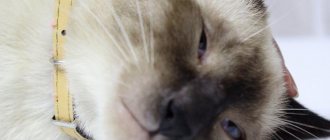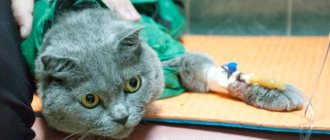10204Administration
What should you do if your cat's ears are itchy and black? Inexperienced cat owners often make the mistake of mistaking black or brown plaque in their pet's ears for earwax or dirt. Some simply make no attempt to get rid of it, others simply clean the “dirt” with a cotton swab. In fact, if a cat has black ears, then this is a clear sign of a disease called “otodecosis.” It is caused by microscopic mites. In this case, it is necessary to urgently take treatment measures.
The second name for this common disease in cats and dogs is ear scabies. An animal suffering from this disease experiences very severe discomfort and also scratches its ears until they bleed.
© shutterstock
Attention! The opinion that only street animals suffer from otodecosis is erroneous. Even the most well-groomed indoor cat can get sick. The reason for this is parasites that enter the house with the owner's shoes or clothes.
Various dirt in a cat's ear
Every owner of a cat has at least once encountered the fact that strange-colored dirt accumulates in the ear canal of their animal.
The reasons for this vary from the fact that the cat simply got dirty somewhere, to quite serious pathologies, such as otodectosis.
ATTENTION! But even if the problem lies in the fact that the cat was unable to wash its ears (after all, it is difficult to reach them), this does not mean that you can close your eyes to it.
It is necessary to urgently clean out the accumulated dirt. You need to do this:
- Wrap your pet in a blanket or blanket in advance.
- Soak the dried plaque with Vaseline or vegetable oil.
- Using cotton swabs for children for cleansing.
You cannot clean your ears using plain water or regular creams. Blackness in cats will not go away, and inflammation can easily occur due to the use of water.
If you again notice strange dirt that does not disappear, then, unfortunately, this is a symptom of a serious pathology.
Cat treatment
A veterinarian should treat a cat with ear pathologies after conducting a comprehensive examination and identifying the cause of the formation of brown plaque. Self-medication is fraught with aggravation of the animal’s condition or the death of your beloved pet.
For otodectosis the following is prescribed:
- mechanical cleaning of the animal’s ears from plaque, pus and dried crusts using disinfectant solutions;
- acaricidal drugs;
- vitamin and immunostimulating agents;
- disinfection of premises and care items;
- treatment of other pets.
When otitis of the external, middle or inner ear is detected, therapy consists of the use of the following drugs:
- disinfectant solutions for cleaning the ear;
- antibacterial and anti-inflammatory drops and ointments;
- painkillers;
- novocaine blockades;
- injectable antibiotics;
- vitamins;
- immunomodulators;
- diet.
Causes and diseases
The voluminous plaque that owners notice in the ear canal is not always brown. It is often black. The presence of a dark substance in the ear canal means that the pet is most likely sick.
What exactly depends on the symptoms, but there are three main problems that almost every owner can face. If a cat's ears itch inside, what should I do? It's natural to contact your veterinarian before it's too late.
How to determine if it is a tick
The danger of becoming infected with ear mites exists even when the animal does not leave the house. A person can bring infection into the house along with shoes or clothing. The arthropod penetrates the cat's ear, settles there and reproduces.
An infected cat immediately changes in behavior: it becomes apathetic, it loses interest in toys and things, and the animal is indifferent even to its favorite treats. In return, the owner may get an aggressive and timid pet that does not make contact with humans and avoids touching, especially the ears.
Particular attention should be paid to the nature of the plaque. The discharge is dark brown in color, difficult to remove, and the substance itself smells unpleasant. In addition, traces of pus or blood may appear.
If there is a tick, the cat becomes restless and tries to scratch its ears all the time. Sometimes he may sit with his head slightly tilted to the side.
When the disease becomes advanced, black crusts begin to fall out of the cat’s ears, and treatment of the chronic form becomes labor-intensive and the most expensive. If you notice the first signs of ear mites, you should immediately contact a veterinarian.
What is black plaque in the ears? These photos will help you figure it out:
The doctor will scrape the animal’s ears, conduct an analysis, identify the source of the disease and prescribe appropriate treatment. In the initial form of infection, ear drops can be used, but the advanced form will require treatment with antibiotics and painkillers.
Also, during treatment, your pet must be given special food and vitamins to support the immune system and speed up recovery.
The incubation period for ear mites is 21 days. Therefore, if other animals live in a house with an infected cat, it is better to isolate the sick pet from contact with other inhabitants, and the room should be thoroughly disinfected.
It's worth taking ear mites in your pet seriously. If the necessary measures are taken too late or not at all, the cat may completely lose his hearing.
Dangerous otodectosis
This disease is caused by one of the most dangerous parasites - ear mites. The ear mite is an arthropod that inhabits almost all ear canals and multiplies quickly.
ATTENTION! Initially, it settles in the outer part. Having completely colonized this place, the parasite begins to colonize all canals.
It is not difficult to determine that your animal has otodectosis - dirt continues to accumulate even after it is removed, if you have identified this symptom, treatment must begin immediately.
The pathology has a couple of stages, on which the method of treatment depends:
- Initial.
- Launched.
Each of them is distinguished by different symptoms:
- At the initial stage, the dirt coming out of the shell is dry, like the surface of the ear itself. There are no scratches, but there are black dots.
- At the last stage, the plaque becomes a little viscous, the ear canal becomes inflamed due to the formation of colonies of fungi and parasites.
When treating the initial phase of the disease, it is enough to use Otodexin ear drops, aerosols and lotions. And the second will require the use of antibiotics and antimycotic drugs.
At any phase of the disease, before starting the procedures, it is necessary to remove the plaque and crust that has formed on the surface of the ear.
The best medicines to combat these parasites are insecticide-based drugs. The only thing worth remembering is that they act specifically on living ticks, but are practically ineffective at killing larvae.
Since the incubation period of infection is twenty-one days, the course of treatment should last at least three weeks. If you stop treatment early, a relapse is possible.
Formation of sulfur plugs
If your cat belongs to a breed with a unique ear structure, for example, Sphynx, then most likely the cause of dirt inside the ears is considered to be wax plug. It’s just that such pets often produce sulfur. It accumulates, and various microbes develop in it.
The sulfur plugs themselves, although they cause discomfort to the pet, are dangerous. True, sometimes they can lead to an inflammatory process.
IMPORTANT! The main way to treat traffic jams at home is to use a medicated lotion.
After applying the medicine, it dissolves. If this still does not help, then consult a doctor.
Dermatitis
The cat's ears on the head turn red as a result of simple dermatitis, which occurs when the mechanical ones are damaged. When any scratches, burns, etc. appear. In this case, red spots are also noticed near the ears.
In fact, this is an elementary inflammation that is treated with the most common anti-dermatosis drugs. As you can see, a cat’s ears turn red for various reasons, but treatment is always necessary, since otherwise the disease will be neglected and lead to dire consequences.
Otitis and its varieties
The accumulation of sulfur can be a symptom of a serious illness, for example, otitis media causes similar problems. This is usually the name for a terrible inflammation of one of the ear canals.
Otitis is divided into:
- External.
- Medial.
- Interior.
The first type of disease is the easiest to treat. Otitis externa can be determined by the fact that the pet has not only dark plaque in the ears, but also an unpleasant odor. Another sign of the disease is severe itching in the ear area.
Medial otitis is most often considered a consequence of improper treatment. If the external type of otitis can be cured with the help of home remedies, such as Bars drops, then with the second and third types everything is more complicated due to the structure of the ear. It is practically impossible to do without the help of a doctor.
The main symptoms of the second stage:
- Continuous discharge of fluid from the ear canal.
- Squelching sounds.
- The animal does not allow you to touch its ear.
- Loss of appetite.
- Stench from the ears.
The worst stage is considered internal otitis, since it can lead to the pet going deaf due to the development of pathology.
ATTENTION! The only treatment option is veterinary assistance.
Before performing any treatment chosen by the owner, a sick pet needs to clean the ears of dark plaque as thoroughly as possible.
Cleaning will not only help remove some parasites from your cat's ears, but will also ensure that medications can get into the affected area.
How to get rid of the problem
If your cat has red spots on his ears that do not disappear within 2-3 days, then you need to sound the alarm. It is extremely difficult to independently determine the cause of the disease, because there is always a risk of incorrect interpretation of the symptoms.
If a cat has red spots in his ears, which also fester, then we can talk about a simple abscess. The animal could have been injured during a walk, and now this same wound is rotting. In this case, the problem area should be carefully washed and then lubricated with iodine or hydrogen peroxide. If there is severe infection on the face, you must contact a veterinarian, otherwise the animal may die.
It is not worth eliminating ringworm or ear mites using improvised means, since a person without specialized education can only worsen the situation. If you find signs of the first or second disease, you should consult a doctor. Ear mites, like lichen, are dangerous diseases, and the sooner they are eliminated, the better. They get rid of ticks using special ear drops that contain poison for the insect, but are safe for your pet. Also, the cat owner needs to regularly wipe dirty ears and rinse them so that the weakened body does not end up picking up some kind of infection. Ticks especially often bother animals that move uncontrollably outside.
If a cat has red spots on its ears that do not cause it much discomfort, then we may be talking about skin pigmentation disorders. Of course, to confirm the diagnosis, you should consult a doctor, but usually this problem is easily treated and does not threaten the pet’s life.
If red spots appear due to the development of lichen, then you should get rid of the disease with the help of Vacderm and Microderm preparations. The medications themselves must be prescribed by a veterinarian, since it is important to take into account the individual characteristics of the cat’s body.
Small red spots can be the first alarming symptom indicating the development of a truly serious disease. But an independent fight against an unknown disease can result in a deterioration in the pet’s condition.
Hello!
When did you perform routine deworming? When was the animal vaccinated and with what vaccine? What additional vitamin supplements do you use? This is very important diagnostic information. Please provide it as soon as possible.
Please note that feeding Whiskas, Friskas, Meow, Felix and Kitiket, Optimil is not recommended for feeding cats. Neither dry nor wet. These are very harmful foods that can sooner or later provoke gastrointestinal diseases and quite often lead to the death of the animal. Sausages, milk, soups, borscht and all other “things that we eat ourselves” are not suitable for feeding cats. This rule is. Feed your animal either a high-quality commercial food: Acana, Gina, Orijen, Hills, Royal Canin, Eukanuba, Go Natural or Now Fresh. Or natural products: rice, oatmeal, buckwheat + beef, turkey, rabbit (not in the form of minced meat) and stewed vegetables (cabbage, cauliflower, carrots, beets). The percentage of meat in the main diet is at least 70%. Also remember that you should never mix natural food and industrial feed. Vitamins must be used for any type of diet, for 1-1.5 months. 2 r. in year.
It is necessary to scrape the ear canal, conduct microscopy and confirm or refute the diagnosis of ear mites - otodectosis. The cat's ear itched, so he scratched the back of his ear. Perhaps there is no tick, but the animal usually has alimentary otitis media. Nevertheless, the treatment remains complex.
- Wipe with hydrogen peroxide 2 times a day - up to 14 days. We wipe the inside of the ear and ear canal, removing grayish-brown discharge, until completely clean. The cotton swab should be damp and nothing should get inside the ear canal.
- Chlorhexidine or Miramistin 2 times a day - up to 14 days. We wipe the inside of the ear and ear canal, previously treated with peroxide. The cotton swab should be damp and nothing should get inside the ear canal.
- Lubricate the inside of the cat's ear with Bepanten or Celestoderm or DE (DK) Cream (vet.) 2 times a day - up to 14 days.
- Sofradex or Jenodex drops 2-3 drops in each ear 2 times a day - up to 14 days. It is possible (in the most difficult situation) to use “complex” drops (Cefazolin or Reflin or Ceftriaxone or Cefogram or Axetin (Cefuroxime) 1 g (1 vial) + Dioxidin 10 ml + Novocaine 0.5% 5 ml + Suprastin 2 ml + Dexamethasone 3 ml + B12 2 ml + Dimexide 0.5-1 ml (optional). The resulting mixture, 2-3 drops in each ear 2 times a day - up to 14 days. The option for using the antibiotic Cefazolin is the “simplest” and, accordingly, Aksetin ( Cefuroxime) is the most “difficult”.
If we are still talking about otitis media caused by Otodectosis, then...
The second stage includes cleaning the ears 2 times a day using a special suspension, which it is advisable to prepare yourself: DE Cream (DK or Doctor) 30 ml + Dioxidin 5 ml + Creolin 2 ml. Bring the resulting mixture to a homogeneous state to obtain a coffee-colored suspension. Place the suspension in the ear 2 times. in a volume of 0.5-1.0 ml, massage its root for 3-5 minutes. and then remove with a cotton swab and ear swab until the ear canal is completely clean. Repeat the procedure 2 times. in the village - up to 14 days. Also, at the moment, you can use a simpler, but also more expensive method of treating otodectosis, using insectoacaricidal drops “Advocate”. During the second stage of treatment, instead of Creolin suspension, 1 time every 7 days. Advocate drops 2-3 drops are instilled into the ear canal. 1 time every 7 days. - up to 5-7 times (5-7 weeks).
If the problem is related to allergic otitis media, it is necessary to normalize the animal’s diet. Please let us know about this further.
Treatment of wounds on the outer side of the auricle caused by claws must be done as standard.
Consecutively Peroxide, Furacilin, Chlorhexidine, removing ichor and other secretions until completely clean, 2 r. in the village - up to 7-10 days. Around the wound Iodine 5% 2 r. in the village up to 12 days. Locally, lubricate with Levomikol or Algofin 2-3 r. in the village up to 12 days. If necessary, wear a plastic veterinary collar for 2-3 weeks to prevent injury.
Inform regularly about the animal's condition.
Health to your pets!
Vetpraktika team
«
If the owner of a cat of any breed knows the main symptoms of the most common ailments among them, then he will never allow the disease to develop and its advanced stage, since he will be able to show the animal to a veterinarian in time and begin the correct necessary treatment.
If you look closely at the brown coating on the animal’s ears, you will notice that its structure is similar to the grounds left after drinking coffee. In addition, if there are mites, this very plaque has a very unpleasant and even quite pungent odor.
If the owner of a feline has such an opportunity, then it is best to take your pet to a veterinarian as soon as possible. But in general, you can cope with the problem yourself. To do this, you just need to purchase a special drug to combat ear mites. For example, a special medicinal liquid “Bars” would be an excellent option. It is sold in pet stores and specialized veterinary pharmacies. In addition to the high effectiveness of such a drug, its attractive cost can also be noted as an advantage.
It is best to first securely secure the animal with a thick blanket to avoid painful scratches. The cat's ear is carefully turned out so that its internal cavity becomes visible, after which the brown plaque that has appeared is carefully removed from its surface with a cotton swab dipped in the purchased medicinal solution. The main thing is to do it slowly and carefully so as not to hurt the animal. It is best to try to change quickly dirty cotton swabs more often.
Veterinarians note that the result of such cleaning can be consolidated with the help of boric acid. A small amount is poured into the cat's ear immediately after the procedure. The main thing is to pour the substance not into the ear canal, but precisely into those places where the unpleasant-smelling brown plaque was previously located.
It is very important to “wield” the cotton swab only at a minimum depth. Otherwise, the pet owner can seriously damage his pet's ear. For example, due to a damaged eardrum, a cat may completely lose hearing.
Every owner wants their pet to be healthy and cheerful, but sometimes the cat starts shaking its head and scratching its ears. Such symptoms cause diseases of the ear. How to help your pet? Let's look at the most common ear diseases in cats.
Rules for the use of drugs
The sequence of manipulations during the treatment process should be as follows:
- Before instilling or using ointment, you need to clean the surface of the ear from dirt, crusts and pus. This is done with a cotton swab soaked in special alcohol (2%) or hydrogen peroxide. Alternatively, you can use other disinfectants designed for treating ears.
- When the plaque becomes limp and “moves away” from the skin, it can be easily removed with a cotton swab. Most often, the cat itself removes all the dirt from its ears with its paws.
- In order for the medicine to get deep into the ear canal and be perfectly absorbed, it is necessary to massage the base of the ear with light movements.
- The dosage of lotion must fully comply with the instructions or doctor's prescription.
- If there is another cat or other pets living in the apartment, it is recommended to ventilate the rooms more often and perform wet cleaning during therapy. Thus, the likelihood of recurrent disease and infection of healthy animals is reduced.
Prevention
To protect your animal from such a problem as ear disease, you need to systematically follow simple tips:
- check your cat’s ears and clean them once every two weeks; this is not dangerous if you follow the veterinarian’s recommendations;
- buy lotion (for example, “Bars”), drops and cotton swabs at a special pharmacy;
- do not turn a blind eye to even the slightest signs of disease, because any little thing can seriously affect the health and life of the animal;
- be attentive to the cat, observe its habits and call a doctor if you have any suspicions.
For prevention, the drug most often prescribed is Revolution for Cats, which is easy to find in Moscow. It should be applied to the withers using the drop method.
After absorption into the skin, the active substance affects both ticks and fleas, if any.
Pet owners know that even ordinary dirt in the ear canal can be the first symptom of pathology. If you don’t delay full treatment, then everything will go well. But to avoid troubles, it is better to simply carry out prevention and constantly clean the animal’s ears.
Diagnosis and treatment
If your kitten has brown dirt in his ears, it may be due to a lack of pet hygiene. At the first stage of diagnosis, it is necessary to distinguish increased secretion of earwax from the disease.
Signs of a violation are as follows:
- ear scratching;
- the pet periodically shakes its head and tilts it towards the disturbing ear;
- discharge - clear or purulent;
- the animal looks restless or, conversely, apathetic, loses appetite;
- increased body temperature;
- the presence of edema, swelling and rashes;
- unpleasant odor;
- the presence of wounds, hematomas, scabs or crusts;
- purulent formations or tumors.
- external inspection of the surface by a veterinarian using instruments;
- otoscopy - examination of the ear canal using a special device after anesthesia. Allows you to identify the presence of foreign objects, neoplasms and inflammation, determine the integrity of the eardrum;
- scraping of cellular material from the auricle and ear canal, followed by analysis.
Otoscopy - examination of the ear canal using a special device
After making a diagnosis, it is necessary to isolate the sick animal from healthy ones, and in the case of scabies mites, from contact with other people.
Animals infected with scabies mites are washed with warm water and zoo shampoo, washing off all crusts and pus. Anti-mite gels and ointments are applied to the cat's clean skin.
If necrosis, abscess or tumor is detected, the doctor may decide whether surgery is necessary.











